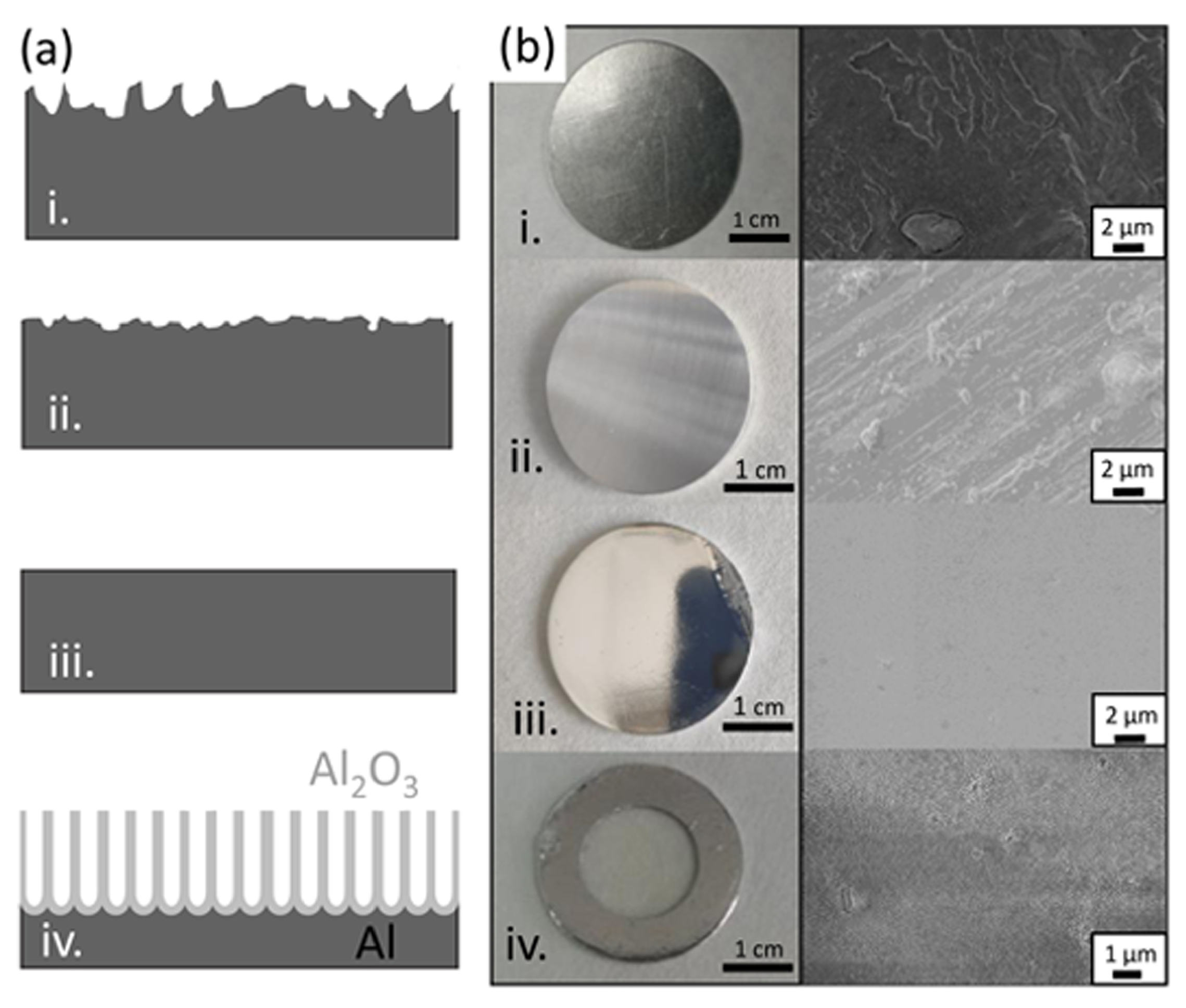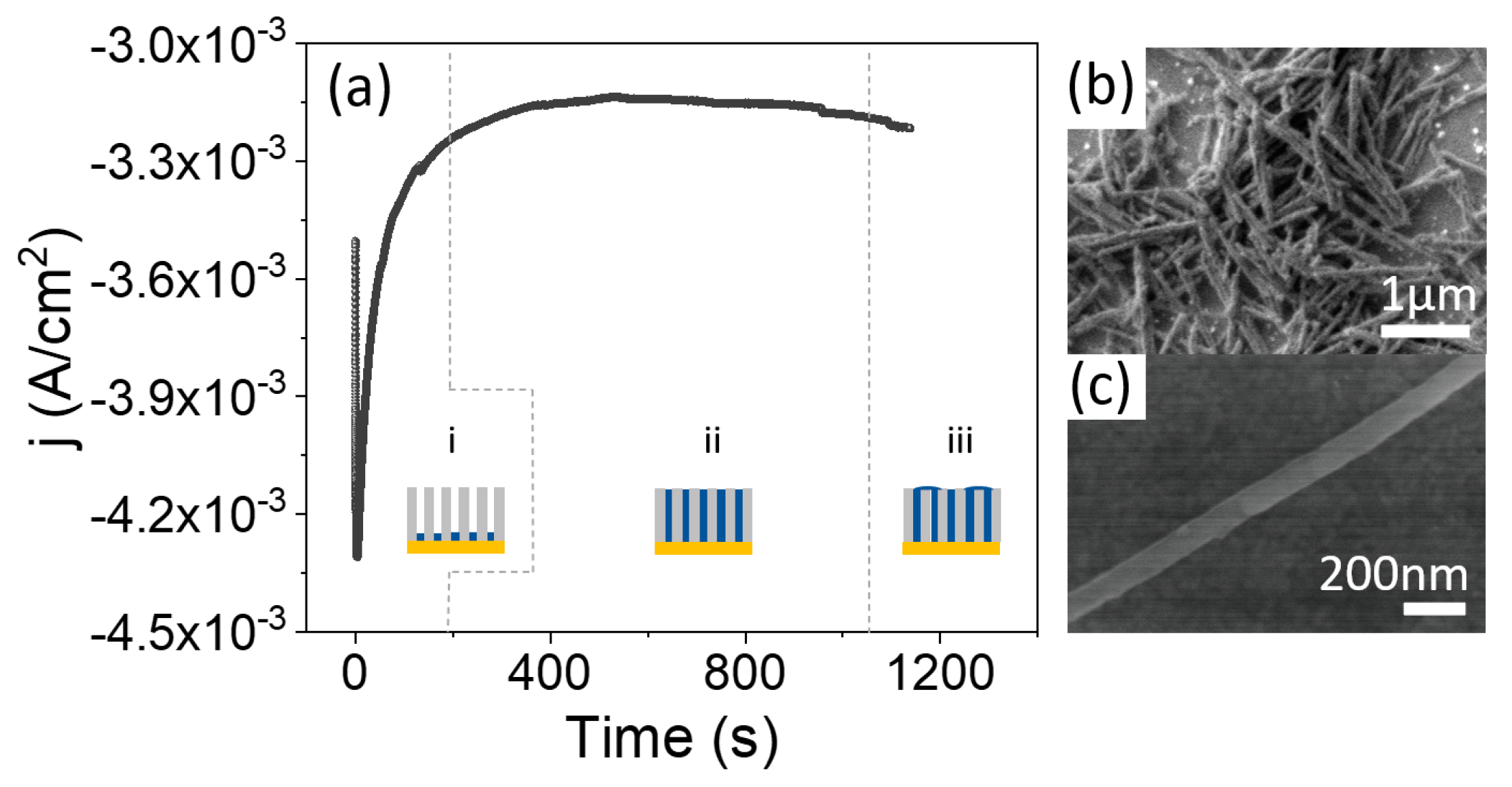Scaling Up the Production of Electrodeposited Nanowires: A Roadmap towards Applications
Abstract
:1. Introduction
2. Materials and Methods
3. Results and Discussion
3.1. Anodization of Recycled Aluminum
3.2. Growth of NWs for the Synthesis of Magnetic Nanocomposites
4. Conclusions
Author Contributions
Funding
Data Availability Statement
Acknowledgments
Conflicts of Interest
Sample Availability
Abbreviations
| NW | nanowire |
| AAO | anodized aluminum oxide |
| SEM | scanning electron microscopy |
| XAS | X-ray absorption spectrum |
| XMCD-PEEM | PhotoEmission Electron Microscopy with X-ray Magnetic Circular Dichroism contrast |
References
- Rubia-Rodríguez, I.; Santana-Otero, A.; Spassov, S.; Tombacz, E.; Johansson, C.; De La Presa, P.; Teran, F.J.; Morales, M.D.P.; Veintemillas-Verdaguer, S.; Thanh, N.; et al. Whither Magnetic Hyperthermia? A Tentative Roadmap. Materials 2021, 14, 706. [Google Scholar] [CrossRef]
- Marcus, M.; Smith, A.; Maswadeh, A.; Shemesh, Z.; Zak, I.; Motiei, M.; Schori, H.; Margel, S.; Sharoni, A.; Shefi, O. Magnetic Targeting of Growth Factors Using Iron Oxide Nanoparticles. Nanomaterials 2018, 8, 707. [Google Scholar] [CrossRef] [PubMed] [Green Version]
- Krasia-Christoforou, T.; Socoliuc, V.; Knudsen, K.D.; Tombácz, E.; Turcu, R.; Vékás, L. From Single-Core Nanoparticles in Ferrofluids to Multi-Core Magnetic Nanocomposites: Assembly Strategies, Structure, and Magnetic Behavior. Nanomaterials 2020, 10, 2178. [Google Scholar] [CrossRef] [PubMed]
- Pradhan, D.K.; Kumari, S.; Rack, P.D. Magnetoelectric Composites: Applications, Coupling Mechanisms, and Future Directions. Nanomaterials 2020, 10, 2072. [Google Scholar] [CrossRef] [PubMed]
- Roca, A.G.; Costo, R.; Rebolledo, A.F.; Veintemillas-Verdaguer, S.; Tartaj, P.; Gonzalez-Carreno, T.; Morales, M.P.; Serna, C.J. Progress in the preparation of magnetic nanoparticles for applications in biomedicine. J. Phys. D Appl. Phys. 2009, 42, 224002. [Google Scholar] [CrossRef]
- Kudr, J.; Haddad, Y.; Richtera, L.; Heger, Z.; Cernak, M.; Adam, V.; Zitka, O. FMagnetic Nanoparticles: From Design and Synthesis to Real World Applications. Nanomaterials 2017, 7, 243. [Google Scholar] [CrossRef] [PubMed]
- Galdun, L.; Szabo, P.; Vega, V.; Barriga-Castro, E.D.; Mendoza-Resández, R.; Luna, C.; Kovac, J.; Milkovic, O.; Varga, R.; Prida, V.M. High Spin Polarization in Co2FeSn Heusler Nanowires for Spintronics. ACS Appl. Nano Mater. 2020, 3, 7438–7445. [Google Scholar] [CrossRef]
- Gapin, A.I.; Ye, X.R.; Aubuchon, J.F.; Chen, L.H.; Tang, Y.J.; Jin, S. CoPt patterned media in anodized aluminum oxide templates. J. Appl. Phys. 2006, 99, 08G902. [Google Scholar] [CrossRef]
- Domínguez-Bajo, A.; Rodilla, B.L.; Calaresu, I.; Arché-Nuñez, A.; González-Mayorga, A.; Scaini, D.; Pérez, L.; Camarero, J.; Miranda, R.; López-Dolado, E.; et al. Interfacing Neurons with Nanostructured Electrodes Modulates Synaptic Circuit Features. Adv. Biosyst. 2020, 4, 2000117. [Google Scholar] [CrossRef]
- Brüggemann, D.; Wolfrum, B.; Maybeck, V.; Mourzina, Y.; Jansen, M.; Offenhäusser, A. Nanostructured gold microelectrodes for extracellular recording from electrogenic cells. Nanotechnology 2011, 22, 265104. [Google Scholar] [CrossRef]
- Peng, F.; Su, Y.; Ji, X.; Zhong, Y.; Wei, X.; He, Y. Doxorubicin-loaded silicon nanowires for the treatment of drug-resistant cancer cells. Biomaterials 2014, 35, 5188–5195. [Google Scholar] [CrossRef] [PubMed]
- Martínez-Banderas, A.I.; Aires, A.; Quintanilla, M.; Holguín-Lerma, J.A.; Lozano-Pedraza, C.; Teran, F.J.; Moreno, J.A.; Perez, J.E.; Ooi, B.S.; Ravasi, T.; et al. Iron-Based Core-Shell Nanowires for Combinatorial Drug Delivery and Photothermal and Magnetic Therapy. ACS Appl. Mater. Interfaces 2019, 11, 43976–43988. [Google Scholar] [CrossRef] [PubMed]
- Martín-García, L.; Ruiz-Gomez, S.; Abuín, M.; Montana, Y.; Carmona, N.; Pérez, L. Multifunctional Core-Shell Co-SiO2 Nanowires via Electrodeposition and Sol-Gel Techniques. RSC Adv. 2015, 5, 97503–97507. [Google Scholar] [CrossRef] [Green Version]
- Cherevko, S.; Chung, C.H. Gold nanowire array electrode for non-enzymatic voltammetric and amperometric glucose detection. Sens. Actuators B Chem. 2009, 142, 216–223. [Google Scholar] [CrossRef]
- Du, F.; Shi, L.; Zhang, Y.; Li, T.; Wang, J.; Wen, G.; Alsaedi, A.; Hayat, T.; Zhou, Y.; Zou, Z. Foam–like Co9S8/Ni3S2 heterostructure nanowire arrays for efficient bifunctional overall water–splitting. Appl. Catal. B 2019, 253, 246–252. [Google Scholar] [CrossRef]
- Hsieh, C.T.; Huang, C.L.; Chen, Y.A.; Lu, S.Y. NiFeMo alloy inverse-opals on Ni foam as outstanding bifunctional catalysts for electrolytic water splitting of ultra-low cell voltages at high current densities. Appl. Catal. B 2020, 267, 118376. [Google Scholar] [CrossRef]
- Serra, A.; Valles, E. Advanced electrochemical synthesis of multicomponent metallic nanorods and nanowires: Fundamentals and applications. Appl. Mater. Today 2018, 12, 207–234. [Google Scholar] [CrossRef]
- Nunez, A.; Pérez, L.; Abuín, M.; Araujo, J.P.; Proenca, M.P. Magnetic behaviour of multisegmented FeCoCu/Cu electrodeposited nanowires. J. Phys. D Appl. Phys. 2017, 50, 155003. [Google Scholar] [CrossRef]
- Vorobjova, A.; Tishkevich, D.; Shimanovich, D.; Zubar, T.; Astapovich, K.; Kozlovskiy, A.; Zdorovets, M.; Zhaludkevich, A.; Lyakhov, D.; Michels, D.; et al. The influence of the synthesis conditions on the magnetic behaviour of the densely packed arrays of Ni nanowires in porous anodic alumina membranes. RSC Adv. 2021, 11, 3952. [Google Scholar] [CrossRef]
- Ruiz-Clavijo, A.; Ruiz-Gomez, S.; Caballero-Calero, O.; Perez, L.; Martin-Gonzalez, M. Tailoring Magnetic Anisotropy at Will in 3D Interconnected Nanowire Networks. Phys. Status Solidi RRL 2019, 13, 1900263. [Google Scholar] [CrossRef]
- Tischkevich, D.I.; Vorobjova, A.I.; Vinnik, D.A. Formation and corrosion behaviour of Nickel/Alumina Nanocomposites. Solid State Phenom. 2020, 299, 100–106. [Google Scholar] [CrossRef]
- Alnassar, M.Y.; Ivanov, Y.P.; Kosel, J. Flexible magnetoelectric nanocomposites with tunable properties. Adv. Electron. Mater. 2016, 2, 1600081. [Google Scholar] [CrossRef]
- Guzmán-Mínguez, J.C.; Ruiz-Gómez, S.; Vicente-Arche, L.M.; Granados-Miralles, C.; Fernández-González, C.; Mompeán, F.; García-Hernández, M.; Erohkin, S.; Berkov, D.; Mishra, D.; et al. FeCo Nanowire—Strontium Ferrite Powder Composites for Permanent Magnets with High-Energy Products. ACS Appl. Nano Mater. 2020, 3, 9842–9851. [Google Scholar] [CrossRef]
- Toimil-Molares, M.E. Characterization and properties of micro- and nanowires of controlled size, composition, and geometry fabricated by electrodeposition and ion-track technology. Beilstein J. Nanotechnol. 2012, 3, 860–883. [Google Scholar] [CrossRef] [PubMed]
- Sousa, C.; Leitao, D.; Proenca, M.; Ventura, J.; Pereira, A.; Araujo, J. Nanoporous alumina as templates for multifunctional applications. Appl. Phys. Rev. 2014, 1, 031102. [Google Scholar] [CrossRef]
- Ruiz-Clavijo, A.; Caballero-Calero, O.; Martín-González, M. Revisiting anodic alumina templates: From fabrication to applications. Nanoscale 2019, 13, 2227–2265. [Google Scholar] [CrossRef]
- Tishkevich, D.I.; Vorobja, A.I.; Vinnik, D.A. Template assisted Ni Nanowires Fabrication. Mater. Sci. Forum 2019, 946, 235–241. [Google Scholar] [CrossRef]
- Tishkevich, D.I.; Vorobja, A.I.; Vinnik, D.A. Thermal Stability of Nano-Crystalline Nickel Electrodeposited into Porous Alumina. Solid State Phenom. 2020, 299, 281–286. [Google Scholar] [CrossRef]
- Elmekawy, A.; Iashina, E.; Dubitskiy, I.S.; Sotnichuk, S.V.; Bozhev, I.; Napolskii, K.S.; Menzel, D.; Mistonov, A.A. Magnetic properties and FORC analysis of iron nanowire arrays. Mater. Today Commun. 2020, 25, 101609. [Google Scholar] [CrossRef]
- Zaraska, L.; Stepniowski, W.J.; Ciepiela, E.; Sulka, G.D. The effect of anodizing temperature on structural features and hexagonal arrangement of nanopores in alumina synthesized by two-step anodizing in oxalic acid. Thin Solid Films 2013, 534, 155–161. [Google Scholar] [CrossRef]
- Hao, Q.; Huang, H.; Fan, X.; Hou, X.; Yin, Y.; Li, W.; Si, L.; Nan, H.; Wang, H.; Mei, Y.; et al. Facile design of ultra-thin anodic aluminum oxide membranes for the fabrication of plasmonic nanoarrays. Nanotechnology 2017, 28, 105301. [Google Scholar] [CrossRef] [PubMed]
- Zhang, Z.; Shimizu, T.; Senz, S.; Gösele, U. Ordered High-Density Si [100] Nanowire Arrays Epitaxially Grown by Bottom Imprint Method. Adv. Mater. 2009, 21, 2824–2828. [Google Scholar] [CrossRef]
- Lee, W.; Park, S.J. Porous anodic aluminum oxide: Anodization and templated synthesis of functional nanostructures. Chem. Rev. 2014, 114, 7487–7556. [Google Scholar] [CrossRef]
- Bruera, F.A.; Kramer, G.R.; Vera, M.L.; Ares, A.E. Synthesis and morphological characterization of nanoporous aluminum oxide films by using a single anodization step. Coatings 2019, 9, 115. [Google Scholar] [CrossRef] [Green Version]
- Ali, G.; Ahmad, M.; Akhter, J.I.; Maqbool, M.; Cho, S.O. Novel structure formation at the bottom surface of porous anodic alumina fabricated by single step anodization process. Micron 2010, 41, 560–564. [Google Scholar] [CrossRef]
- Voon, C.H.; Derman, M.; Hashim, U.; Ahmad, K.R.; Ho, L.N. A simple one-step anodising method for the synthesis of ordered porous anodic alumina. J. Exp. Nanosci. 2014, 9, 106–112. [Google Scholar] [CrossRef] [Green Version]
- Ali, G.; Maqbool, M. Fabrication of cobalt-nickel binary nanowires in a highly ordered alumina template via AC electrodeposition. Nanoscale Res. Lett. 2013, 8, 352. [Google Scholar] [CrossRef] [Green Version]
- Kozhukhova, A.; Du Preez, S.; Bessarabov, D. Preparation of anodized aluminium oxide at high temperatures using low purity aluminium (Al6082). Surf. Coat. Technol. 2019, 378, 124970. [Google Scholar] [CrossRef]
- Michalska-Domańska, M.; Norek, M.; Stępniowski, W.J.; Budner, B. Fabrication of high quality anodic aluminum oxide (AAO) on low purity aluminum—A comparative study with the AAO produced on high purity aluminum. Electrochim. Acta 2013, 105, 424–432. [Google Scholar] [CrossRef]
- Montero-Moreno, J.; Sarret, M.; Müller, C. Influence of the aluminum surface on the final results of a two-step anodizing. Surf. Coat. Technol. 2007, 201, 6352–6357. [Google Scholar] [CrossRef]
- Yu, C.U.; Hu, C.C.; Bai, A.; Yang, Y.F. Pore-size dependence of AAO films on surface roughness of Al-1050 sheets controlled by electropolishing coupled with fractional factorial design. Surf. Coat. Technol. 2007, 201, 7259–7265. [Google Scholar] [CrossRef]
- Aballe, L.; Foerster, M.; Pellegrin, E.; Nicolas, J.; Ferrer, S. The ALBA spectroscopic LEEM-PEEM experimental station: Layout and performance. J. Synchrotron Radiat. 2015, 22, 745–752. [Google Scholar] [CrossRef] [PubMed] [Green Version]
- Foerster, M.; Prat, J.; Massana, V.; Gonzalez, N.; Fontsere, A.; Molas, B.; Matilla, O.; Pellegrin, E.; Aballe, L. Custom sample environments at the ALBA XPEEM. Ultramicroscopy 2016, 171, 63–69. [Google Scholar] [CrossRef] [PubMed]
- Kimling, J.; Kronast, F.; Martens, S.; Böhnert, T.; Martens, M.; Herrero-Albillos, J.; Tati-Bismaths, L.; Merkt, U.; Nielsch, K.; Meier, G. Photoemission electron microscopy of three-dimensional magnetization configurations in core-shell nanostructures. Phys. Rev. B 2011, 84, 174406. [Google Scholar] [CrossRef] [Green Version]
- Ruiz-Gómez, S.; Foerster, M.; Aballe, L.; Proenca, M.P.; Lucas, I.; Prieto, J.L.; Mascaraque, A.; de la Figuera, J.; Quesada, A.; Pérez, L. Observation of a topologically protected state in a magnetic domain wall stabilized by a ferromagnetic chemical barrier. Sci. Rep. 2018, 8, 16695. [Google Scholar] [CrossRef] [PubMed] [Green Version]
- Jamet, S.; Da Col, S.; Rougemaille, N.; Wartelle, A.; Locatelli, A.; Menteş, T.; Burgos, B.S.; Afid, R.; Cagnon, L.; Bochmann, S.; et al. Quantitative analysis of shadow X-ray magnetic circular dichroism photoemission electron microscopy. Phys. Rev. B 2015, 92, 144428. [Google Scholar] [CrossRef] [Green Version]
- Guzmán-Mínguez, J.C.; Vicente-Arche, L.M.; Quesada, A.; Mompeán, F.; García-Hernández, M.; Ruiz-Gómez, S.; Pérez, L.; Berkov, D.; Erohkin, S. Permanent Magnet, Method for Obtaining Same and Uses. ES Patent P201,831,258, 16 December 2019. [Google Scholar]
- Mukhtar, A.; Wu, K.; Cao, X.; Gu, L. Magnetic nanowires in biomedical applications. Nanotechnology 2020, 31, 433001. [Google Scholar] [CrossRef]





| Material | Process | Time | Price | NWs Quantity |
|---|---|---|---|---|
| (h) | (€/cm) | (mg /cm) | ||
| Polycarbonate | — | — | 2 | 0.01 |
| High purity Al | two steps | 48 | 6 | 1.2 |
| Low purity Al | single step | 24 | 0.007 | 1.2 |
| Low purity recycled Al | single step | 24 | 0–0.002 | 1.2 |
Publisher’s Note: MDPI stays neutral with regard to jurisdictional claims in published maps and institutional affiliations. |
© 2021 by the authors. Licensee MDPI, Basel, Switzerland. This article is an open access article distributed under the terms and conditions of the Creative Commons Attribution (CC BY) license (https://creativecommons.org/licenses/by/4.0/).
Share and Cite
Fernández-González, C.; Guzmán-Mínguez, J.C.; Guedeja-Marrón, A.; García-Martín, E.; Foerster, M.; Niño, M.Á.; Aballe, L.; Quesada, A.; Pérez, L.; Ruiz-Gómez, S. Scaling Up the Production of Electrodeposited Nanowires: A Roadmap towards Applications. Nanomaterials 2021, 11, 1657. https://doi.org/10.3390/nano11071657
Fernández-González C, Guzmán-Mínguez JC, Guedeja-Marrón A, García-Martín E, Foerster M, Niño MÁ, Aballe L, Quesada A, Pérez L, Ruiz-Gómez S. Scaling Up the Production of Electrodeposited Nanowires: A Roadmap towards Applications. Nanomaterials. 2021; 11(7):1657. https://doi.org/10.3390/nano11071657
Chicago/Turabian StyleFernández-González, Claudia, Jesús C. Guzmán-Mínguez, Alejandra Guedeja-Marrón, Eduardo García-Martín, Michael Foerster, Miguel Ángel Niño, Lucía Aballe, Adrián Quesada, Lucas Pérez, and Sandra Ruiz-Gómez. 2021. "Scaling Up the Production of Electrodeposited Nanowires: A Roadmap towards Applications" Nanomaterials 11, no. 7: 1657. https://doi.org/10.3390/nano11071657
APA StyleFernández-González, C., Guzmán-Mínguez, J. C., Guedeja-Marrón, A., García-Martín, E., Foerster, M., Niño, M. Á., Aballe, L., Quesada, A., Pérez, L., & Ruiz-Gómez, S. (2021). Scaling Up the Production of Electrodeposited Nanowires: A Roadmap towards Applications. Nanomaterials, 11(7), 1657. https://doi.org/10.3390/nano11071657






